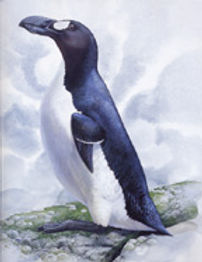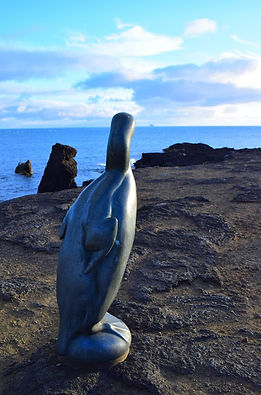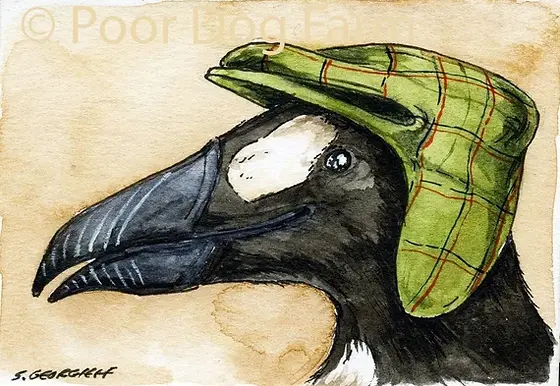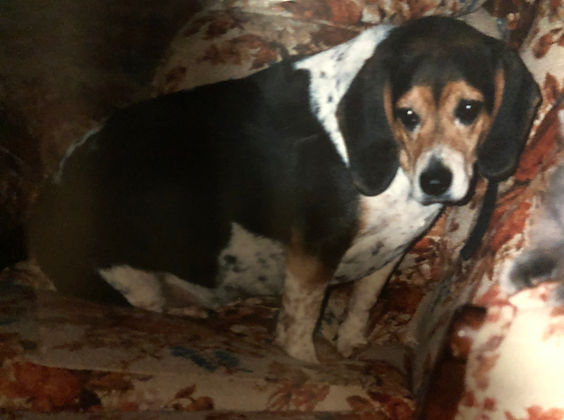Creature
Fast Facts
Introducing you to extinct species.

THE
GREAT AUK
1. The great auk, Pinguinus impennis, ranged throughout the North Atlantic, northern Europe as far south as Spain, Iceland, Greenland, and the coast of North America as far south as Massachusetts, though some great auk bones were discovered in parts of Florida. 2. They were a black and white, flightless bird originally part of the group ‘Pinguinis’. Penguins were not discovered until much later, but sailors named penguins after the great auk because of a similarity in size and appearance. Today they are in the group, ‘Alca’, which includes the dovekie (little auk) and razorbill. 3. Because of their vast range, it went by many names. Ireland = falcóg mhór meaning "big seabird". France = apponatz meaning grand pingouin. Vikings = auk geirfugl meaning "spearbird". England = gairfowl. Inuit = isarukitsok meaning "little wing". 4. Great auks weighed 11 pounds and stood 33 inches tall. 5. The white eye patches on the head of the great auk appeared during mating season, disappearing in during the winter months at sea. 6. The inside of the great auk’s mouth was bright yellow. 7. The great auk was an excellent swimmer, but very awkward on land during its nesting season. This made them easy prey for polar bears and people. 8. The great auk had little fear of people, making it an easy food source for Europeans traveling between Europe and the colonies in North America. 9. The feathers of the great auk were highly prized for stuffing pillows in Europe. There were only 9 known breeding areas known. In some of their former breeding grounds, there are still stone walls used to herd hundreds of great auks. 10. The British government officially passed a law forbidding the killing of great auks for feathers in 1795. Other countries began making laws around this time too. 11. The last documented breeding pair was killed for a museum specimen on Eldey Island off the southwest coast of Iceland on July 3, 1844. The men who killed this pair reportedly crushed an egg in the process. 12. The last great auk nesting colony was on Geirfuglasker off the coast of Iceland, but it sank into the sea when a volcano erupted in 1830.
Extinction
Cometh
Facing the light at the end of the tunnel
EXTINCTION DATE
July 3, 1844
The great auk’s original range included most of the North Atlantic, including the coast of North America, north of Massachusetts as far south as Spain in Europe. The population was estimated to be in the millions. Native Americans and Europeans knew of the great auk and used it for food for a long time. It wasn’t until the discovery of the New World that things began to change. As the crossings of the North Atlantic from Europe to the New World increased, so did the use of great auks for three things, food, oil from their factories for lamps and cooking, but most detrimentally was the use of their down feathers for pillows. Great auks would often return to the same nesting grounds year after year, making them an easy, predictable target for skilled hunters. Where the great auk’s nesting people built rock paths to easily corral and kill hundreds of birds at a time. The pillow trade became such a lucrative business that great auks were plucked of their feathers and left to die later. Great Britain began killing great auks for feathers in 1795. In North America, the great auk became a target of feather hunts with the population decline of eider ducks. The extinct Labrador duck may also have succumbed to the pressures of human hunting. With the population in steep decline, and nations beginning to regulate great auk hunts, the numbers stabilized. Geirfuglasker, Great Auk Rock’, off the coast of Iceland was one of the last major nesting colonies until Nature struck a blow. The whole island sank beneath the sea in 1830. The last great auk in Europe outside of Iceland was captured in Scotland in 1840. When a major storm arose, it was killed for being a witch. Although there was one unconfirmed sighting in Newfoundland, Canada in 1852, the extinction date, most people place its extinction on Eldey Island, a small rocky island off the coast of Iceland (see picture on my bio page). Jón Brandsson, Sigurður Ísleifsson, and Ketill Ketilsson were hired by a collector to seek out the great auk. They killed both adults and Ketilsson accidentally smashed the egg with his boot. Could the great auk live in the North Atlantic today? Although Jurassic Park is fiction, scientists are working on several de-extinction projects. In fact, in 2003 scientists did bring back the extinct Pyrenean ibex, a type of wild goat, for 7 minutes before it died, showing de-extinction is possible. The great auk might be a good candidate. Scientists would potentially use DNA from the 78 skins and 75 eggs in museum specimens to use to try to bring them back to life. Great strides have been made to preserve wildlife and restore habitats since the great auk’s extinction in 1844. If the great auk was brought to life, could it ever be reintroduced to its native homeland in the North Atlantic?
COMING SOON
Although Eldey the great auk did have a return story in my book Deader Than a Dodo, his presonal Lazarus Tale is yet to be written. Eldey the great auk’s account from my book, Deader Than a Dodo Excerpt 1 “You see; many of us here have struggled, like you, with resentment about being forced here because of the disregard of the people for our well-being. I honestly wasn’t always in agreement with helping people like Eldey. Sure I’ve made my peace with my extinction, but Eldey has always wanted to do more,” Astuto explained, “You see Tortoise, he did go back.” “You mean to say that Eldey went extinct twice?” I asked. “Yes, that’s exactly what I am saying. When Eldey went extinct and came to the Garden he was adamant about going back to help people once he found out that he had that choice. Having been here for a century and a half at that point, I tried to tell Eldey it was a bad idea, but he insisted. Eldey said that he saw people who were trying to save the great auks. He saw a renewed compassion on the part of the people that hadn’t been there before. He said many of the remaining great auks died off due to a volcanic eruption during a nesting season, not because of the people.” Astuto explained. “So, what happened when he returned back there, to the Atlantic Ocean I mean?” I prodded. “Eldey formulated a plan to go back to Eldey Island, which was once a great auk breeding colony. He returned hopeful and was in the midst of hatching the egg amidst a group of smaller seabirds when a group of sailors sent by a collector pulled up on a nearby shore. Eldey started toward the men, hopeful that this would be his chance to save his kind and show the people that conservation could work. Unfortunately, this hope was short-lived. As Eldey got closer to the men, he saw they had a bag and several clubs. He still held onto the hope that if he didn’t run, they would simply take him back to England or Iceland to be observed and cared for. Eldey’s mate, on the other hand, panicked and headed toward the sea to escape the men, but she slipped over some rocks. One of the men drew back his club and…” Astuto sighed, seemingly deciding whether to finish his sentence or not. Even though I couldn’t hear Astuto’s thoughts as he could mine, I knew the answer before I asked, “So she didn’t make it? What about Eldey himself and the egg? Did they survive and make it to the collector?” “Sadly, no. One of the other men accidentally stepped on the egg in the nest. At the sight of this, Eldey fled toward the ocean still holding onto the hope that he, himself, could somehow find someone who would be more compassionate. He never made it to the ocean and a big part of him died on the cold, rocky beach that day. There’s a pain in suffering and in facing your demise, but to do so twice is more than most can bear.” “What did you say to him when he came back to the Garden? This place must have helped him deal with his loss, right?” I inquired. “For a long time, he never spoke to me or anyone else. But after a time, more and more animals were going extinct at a faster and faster rate. This seemed to motivate Eldey, and he again expressed a strong desire to help the people. He knew simply starting again on Eldey Island would be in vain, so he brainstormed many ideas that could possibly work. He was figuring out other options and learning what choices we have here. I told him that it was too much for one animal to take on alone. That’s when we realized there was an option we’d never considered,” said the dodo, cocking his head and looking straight into my eyes. Excerpt 2 Next, it was Eldey who gave his concise introduction, “As you all know, I am the great auk, a flightless bird found on islands in the northern Atlantic Ocean. My chosen name is Eldey after the island where I last went extinct.” I felt pain for him as he recalled the story of Eldey’s tragic return that Astuto had told me earlier. “The great auks were used as a food source for sailors and our feathers were used to stuff pillows. People passed laws to end great auk hunts, but the volcanic eruption of 1830 that sank our nesting island of Geirfulasker did not help my kind’s cause. My kind went extinct on July 13, 1840, in Scotland when a group of people captured a great auk and kept it in a cage. I had hoped that these men would help to save my kind, but that night there was a horrible storm. The people thought the great auk was a witch, so killed it. As many of you know, I have been trying to find a way to help the people and decided to go back and try a second time. But sadly, my plan failed, leaving the great auks to become re-extinct on June 3, 1844. I am honored that so many of you turned out tonight eager to help too,” Eldey added before nodding toward the next in line.
More to Explore
All answers lead to more questions


Painting of great auk by James Audubon from the book, The Birds of America
Image from Wikipedia
Great auk adult and egg
on display in
Kelvingrove, Glasgow
Image from Wikipedia

An illustration about the demise of the great auk
Image from
Miora Risen 12 Images

A book about recently extinct species with facts & illustrations
Image from Amazon

Great auk illustration by Peter Schouten
Image from
A Gap in Nature



Daughter pretending to "pet" a great auk at Field Museum in Chicago
Me hugging a
giant great auk I found
in Iceland
Statue of Great Auk placed
in Iceland facing Eldey Island where the bird went extinct.

A great auk illustration
Image from Birdorable

Part of a caricature series called
"100 Extinct Birds"
Image from Poor Dog Farms



